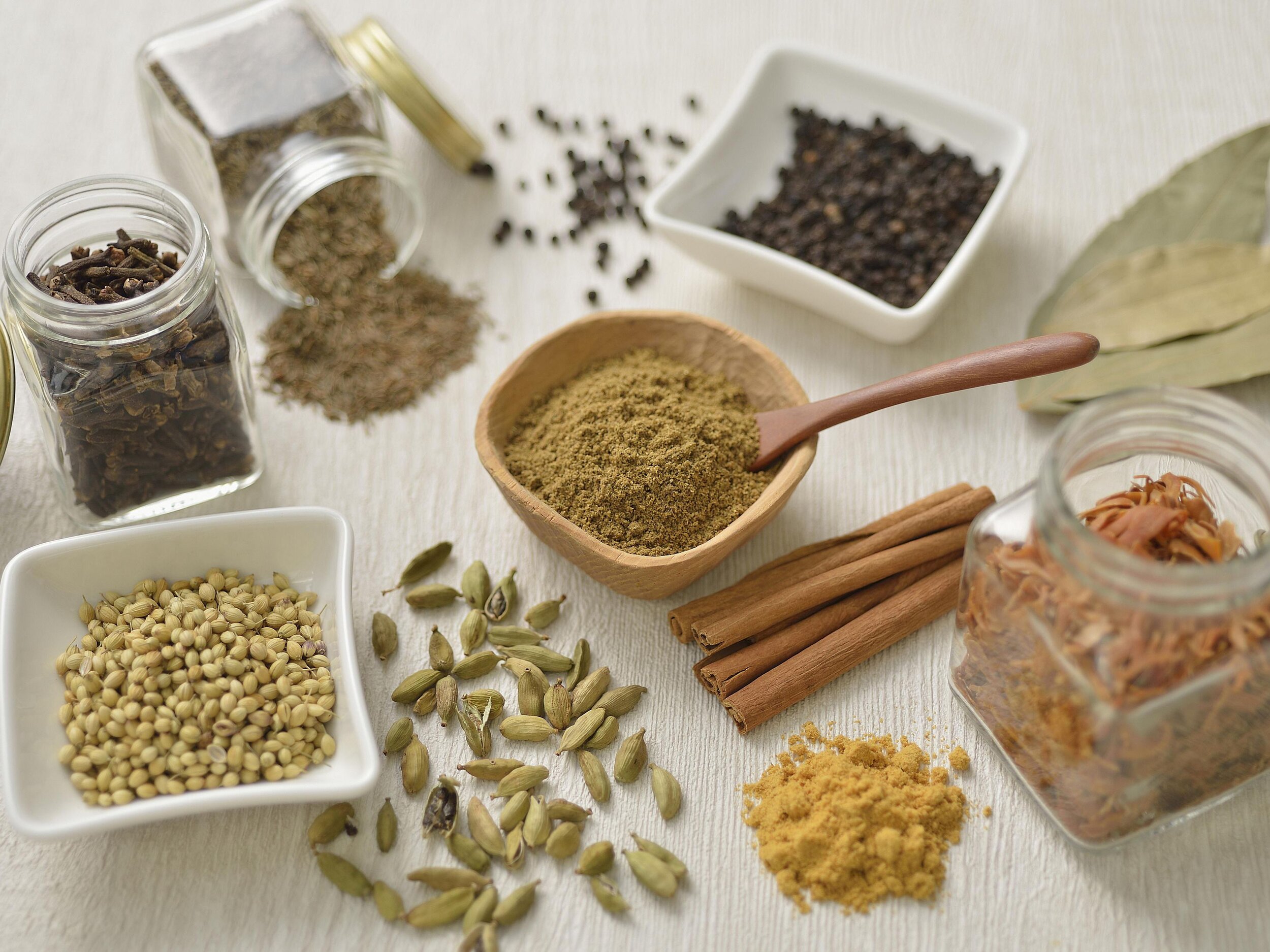Spices
Spices you’ll need if you’re a curry lover
Written By: Anika Akthar
11/02/21
Is your spice rack looking dull with no colour? To cook any Indian dish, a variety of is needed. Indian cooking prides itself in its vibrancy. It’s what defines itself apart from other cuisines. A plateful of Indian food is visually bright and inviting with a tantalising aroma rising through the smoke giving the lucky recipient a taste of the rich flavours. This all comes down to the spices used.
So what are herbs and spices? Spices are retrieved from aromatic bark, roots, seeds and flowers. They provide an enticing smell to a curry, at the same time delivering those infamous curry flavours. They are the backbone of any curry. India has become recognised for it’s influences on seasonings. The bazars with spices spiralling out of their sacks in colourful mounds is often what comes to people’s mind. Dotted around the subcontinent, these bazars go back centuries, often being the focal point of trades from people across all four corners of the world.
Through these trades, spices were beginning to travel across to various parts of the globe, bringing India to the forefront. In fact, even as of today, India is the biggest producer and exporter of spices in the world, yielding 75 of the 100 known variety of spices. The history of spice is central to India and just as fittingly, spices are at the heart of a good curry. Each dish has its own blend of spices which can be modified to fit your palate while still keeping its traditional value. However, there is never one form of an Indian dish. Depending on the region and the recipe, spices and ingredients will vary. Can you spot any of these in your spice cabinet? If not, it might be worth adding to your collection to create a warm and aromatic curry.
Garam Masala
Rightly titled the king of all Indian seasonings, garam masala is a combination of spices that packs a punch when added into any curry. This maharaja sits on a throne of a mix of spices including fennel, bay leaves, peppercorn, cloves, cinnamon, mace, cardamom, cumin, and coriander seeds. The beauty of garam masala is that it can be tailored for your tastebuds. If you want your tongue to dance when tasting an inviting curry, then adding some chilli powder into that mix will do the trick. An extra tip for those who want to get as authentic of a flavour would be to roast this mixture before use. The heat will release those aromatic scents and create that signature curry smell we all know and love. It’s really no wonder how such a powerful mixture of spice holds such a high pedestal.
Turmeric
Like all kings, there must be a queen and this spice reigns colour in Indian cuisine. Turmeric, or haldi as it’s known, is a bright orange spice that gives the vibrant hues that is often associated with curries. This is perhaps one of the most used spice in Indian cooking as it is what gives those intense tones of yellows, reds, and browns. Even in the palest of curries such as a mild korma, you will notice a faint glow of yellow from the turmeric used in the earlier stages of cooking. When cooking, turmeric can be used in its root or powder form.
The fine grounds are added in the early stages of a masala to create that vivid but distinct colour that all curries should have. This is a must for any curry lover and will definitely rule the spice rack.
Coriander Seeds
Can a curry really be called a curry without a healthy dose of coriander? Whether that be a fresh garnish of coriander leaves gently placed on top or whether it is mixed into the masala like it is in its seeded form, this spice is integral to a good curry. One of the many spices included in a garam masala, coriander seeds can be added to a curry to provide that citrusy flavour. If you prefer a more pungent and nutty smell, then roasting the seeds before grounding them will release a warm aroma that will enhance any curry. If the warm smell is just too delicious for you to hold back, then pop a few of those roasted seeds into your mouth. Roasted coriander seeds are often eaten as a snack. Make sure to keep some for you spice jars though!
Chilli
There’s an extensive form of chillies that is used throughout Indian cooking. Ripe chillies can go into a curry to give it a fresh colour while also bringing in that extra kick to the dish. Ground chillies are what gets that deep-rooted spicy flavour while also creating that striking red-brown colour of a fiery masala. Dried chillies have a slightly sweeter taste but don’t be fooled, they can still pack a punch. With different forms of chillies providing a different taste, don’t feel afraid to experiment and see what works. You can add a little if you only desire your tastebuds to tingle or use a variety to see how spicy you can handle it.
Cardamom
Otherwise known as elaichi, this spice is extremely pungent, particularly in the form of cardamom pods. In this form, cardamom is usually used to enhance the aroma of a dish. Use it in a biryani and you will have a great smelling rice dish with the added lightly smoky flavour that cardamom brings. Never again will rice be a boring side dish for any meal. Although this spice is quite expensive, little really does go a long way to those Indian flavours out in your dish. Elaichi powder similarly is only needed in small amounts for any curry. However, this powdered form provides more control since you can sprinkle a little for that hint of sweet and smokiness or pour more for a stronger taste and smell. Whether you use pods or powders, cardamoms are a must for your pantry.
Cumin
A staple in Indian cooking, cumin, or jheera as its known, is a tiny seed that holds so much flavour. The earthy and slightly bitter flavouring bursts through when you add this to a curry. If you want the aromas of cumin to last, then we recommend adding this later on while cooking your curry. Some of the simple ways to implement this into your cooking could be to add the seeds whole to your tarka to top off your daal with that mouth-watering nutty scent. Another way could be to grind the roasted seed and pour some into the curry mixture. Whichever way you decide to use this spice, we know that the inviting smell of cumin will draw you in as you plate up.
The great thing about using spices in Indian cooking is that it’s so versatile. If you need that pop of colour, then turmeric can do that for you. If you want a more aromatic smell, then add a bay leaf. You can play around to find your preference and make a dish your own.
That’s the beauty of Indian cuisine.







